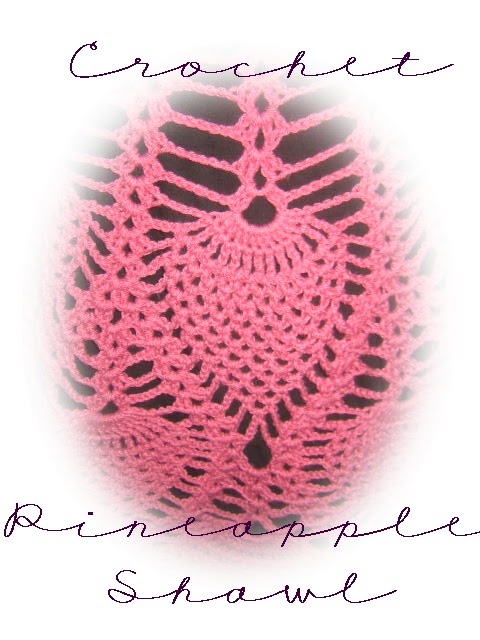Crochet the Pineapple Fan Shawl!

The most famous thread-doily-to-yarn-shawl must be the Pineapple Fan Chair Set However, the directions were written in a time when crochet short-hand was common. The designer assumed that you knew what she was was talking about.
If you want to see the original version, check out celtsvintagecrochet, a Yahoo group. Owner Christine is transferring her vintage patterns into pdf files for your enjoyment. Original name for this pattern is Pineapple Fan Chair Set published by The Canadian Spool Company Copyright 1944
$$$$$$$$$$$$$$$$$$$$$$$$$$$$$$$$$$$$$$$$$$$$$$$$$$$$$$$$$$$$
LEGAL :
I re-wrote the directions in modern terminology, expanded the row count, and took the photos. This is my original work product, derived from a public domain pattern My rights are protected by federal copyright law. You do not have permission to copy my written work product or my photography to sell or to use it in a class. What you do with the crocheted shawl is up to you!
$$$$$$$$$$$$$$$$$$$$$$$$$$$$$$$$$$$$$$$$$$$$$$$$$$$$$$$$$$$$

This is the yarn I used for my shawl, Caron One Pound in the color Rose.

My hook, a vintage Susan Bates, made in the U.S.A., size J/10 or 6mm.
I can get a softer weave with a Boye J hook, but I was going for speed with the Bates.

At the end of my project, all that remained was less than 1/2 ounce yarn.
I believe this is a thicker yarn which means it weighed 16 ounces, but the yardage may be less than Red Heart Super Saver. I use a K hook with Red Heart and I get a nice, drape-y, over-sized shawl.
If you think that you won't have enough yarn, work the first 12 rows with a different color, maybe a variegated would look pretty, or black with deep toned pineapples. for an edgier look.
PART 1 INSTRUCTIONS:

Row 1: Ch 6, join with sl st to first ch to form a ring. Ch 3---counts as the first dc, work 16 more dc in ring. Turn. (17)

Row 2: Ch 3--counts as first dc, don't work in first st of row-, dc in 2nd dc of row and in each of next 14 dc, dc on top of the turning ch-3. Turn.
( 17 dc)

Row 3: Ch 3,dc at base of ch 3- first increase made, 2 dc in each dc and in top of ch-3. Turn. (34 )

Row 4: Ch 3, dc in each of next 32 dc and in top of turning ch-3. (34) Count to make sure. ( 1 ch-3 + 32 dc +dc in top of turning ch= 34)

Row 5: Dc at base of ch 3, * ch 3, skip 2 dc, 2 dc in next dc. Repeat from * across, ending with 2 dc in top of turning ch. Turn. 11 spaces.

This is the 5th row completed with 11 spaces
.

For the remainder of the rows, sl sts are worked across the first 3 stitches to begin the shell pattern.
Row 6: (Sl st in each of next 2 dc and in next sp, ch 3, in same sp make dc, ch 2 and 2 dc---this is a beg shell .); in each ch-3 sp across make
(2 dc, ch 2 and 2 dc---this is a shell). Turn.

This is the sixth row complete with 11 shells.

Row 7: Beg shell, * ch 1, in next ch-2 sp make a shell Repeat from * across. Turn. (11 shells with a ch-1 in between)

Row 8: Beg shell, * ch 2, in next ch-2 sp make 2 dc, ch 2 and 2 dc—shell (shell made over shell). Repeat from * across. Turn. (11 shells with a ch-2 in between)
 Rows:9 to 12 inclusive: Repeat 8th row, having an extra ch between each shell in each row. Row 12 will have 6 chs between shells.
Rows:9 to 12 inclusive: Repeat 8th row, having an extra ch between each shell in each row. Row 12 will have 6 chs between shells.Next time we begin the First row of pineapples!
